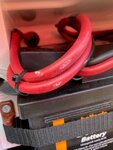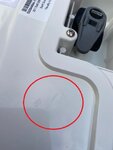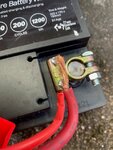- Jan 20, 2023
- 1,310
- 1,167
- 2,435
There's another recent thread on here asking for battery clamp suggestions, just thought I'd remind folks to check theirs.......
We returned home from Broadway yesterday and I have to use the mover to position the wheel accurately for the Alko lock, on opening the battery door to switch the mover on I noticed white marks on the battery cables, I then noticed that this was actually molten plastic from where they'd been touching the inside of the battery box door (photos). Further investigation showed that when the mover had been swapped over when we changed caravans they hadn't trapped it in the battery cable (I pulled it out as in the photo) hence causing a high resistance and heat when using the mover, so next time you're in the battery box, just tug the cables and make sure they're tight!
One other thing, don't overtighten the screws on the clamps, as you WILL strip the threads, as I just did........



We returned home from Broadway yesterday and I have to use the mover to position the wheel accurately for the Alko lock, on opening the battery door to switch the mover on I noticed white marks on the battery cables, I then noticed that this was actually molten plastic from where they'd been touching the inside of the battery box door (photos). Further investigation showed that when the mover had been swapped over when we changed caravans they hadn't trapped it in the battery cable (I pulled it out as in the photo) hence causing a high resistance and heat when using the mover, so next time you're in the battery box, just tug the cables and make sure they're tight!
One other thing, don't overtighten the screws on the clamps, as you WILL strip the threads, as I just did........




